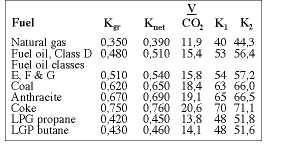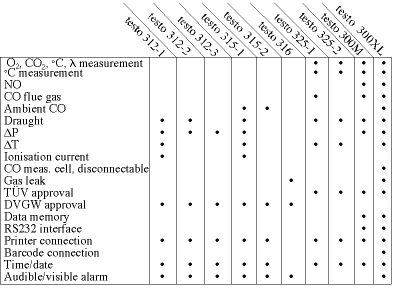Fundamentals of flue gas analysis
May 2001
Analytical Instrumentation & Environmental Monitoring
Ideal operating range of furnaces
The aim of flue gas measuring technology is to ensure the environmentally friendly and economic operation of furnaces. The given formulae and tables can be used to understand flue gas measuring technology. They are also stored in the Testo flue gas analysers. All of the calculations are carried out automatically.
Combustion efficiency is calculated by subtracting the combusting losses from 100% or maximum efficiency.
Efficiency of a small furnace
Equation 1
Taking into account the condensation heat, values of more than 100% are possible in furnaces which operate in the so-called gross calorific value mode. This impossible value shown in the display indicates that the furnace is in the correct operating mode.
Gross and net efficiency
Efficiency values are calculated to give two values, gross and nett. Gross values are calculated including losses due to the water contents of fuels, nett values exclude these losses, this results in the nett value being higher than the gross efficiency.
The most important factor in calculating the efficiency level is the difference between the flue temperature and the ambient temperature. Testo analysers can simultaneously measure both ambient and flue gas temperatures.
Calculation of flue gas efficiency
Calculating CO2
In order to achieve full combustion it is necessary to supply the combustion with more air than is theoretically necessary. The ratio of this air to the theoretical air requirement is known as excess air.
Equation 4
Efficiency
Maximum efficiency is achieved if there is slight air excess and the flue gas efficiency is as high as possible.
Table 1
NOX measurement
NOX consists of NO and NO2. NO2 levels in smaller heating installations which are less than 3% of the total NOX level can be ignored. The measurement of NOX is more important for the correct adjustment of modern NOX reduced burners. However, there is no obligation to measure.
Combustion diagram: ideal operating range of heating installations
Optimum setting of heating installations
Fifteen years ago, chemical kits, the bimetallic thermometer and the soot pump were the only aids available to set the optimum operative range in furnaces.
The chemical kits always had one big disadvantage: a continuous measurement during adjustment work was not possible.
The effect of a correction to a burner setting was not immediately indicated. It is only with the following measurement that a result was shown.
Then reset ... shake again ... set ... shake etc.
This time-consuming and therefore very expensive method of flue gas measurement helped the electronic flue gas analysers to become an immediate success.
Table of fuel-specific factors
Electronic flue gas analysers
The flue gas analysers from Testo have been proving themselves for 15 years. They are ready to operate after one minute and can continuously measure values. In this way the rapid measurement and adjustment of furnaces is guaranteed. The life of the inserted measuring cells is between two and three years.
Features offered by the Testo line of flue gas analysers
Gas measuring cells
The chemical measuring cells in Testo flue gas analysers are used throughout the world and are of the highest technical standard.
Many hours of work are required in research and development to create a suitable environment for the gas cells which includes the optimisation of the gas paths, correct calculation of cross-sensitivities and the uncomplicated method of changing the gas measuring cells by the user.
Fifteen years experience in the development of flue gas analysers as well as many years of cooperation with independent institutes measuring different measuring cell types have given Testo a headstart in this field.
This headstart is passed on to the customer in the form of compact, robust, high precision instruments and easy to change measuring cells.
For further technical details contact Unitemp on tel: (021) 762 8995, [email protected] or
Further reading:
Ensuring clean and safe water
Endress+Hauser South Africa
Editor's Choice Analytical Instrumentation & Environmental Monitoring
Endress+Hauser’s comprehensive range of disinfection sensors is designed to monitor and control disinfectant levels in water treatment processes.
Read more...
High-precision measurement of insulating gases
WIKA Instruments
Analytical Instrumentation & Environmental Monitoring
WIKA has launched the next generation of its GA11 gas analyser. It enables switchgear operators, manufacturers and maintenance companies to record the quality of SF6 gas and alternative insulating gases.
Read more...
Say goodbye to missed contamination with real-time colour monitoring
Analytical Instrumentation & Environmental Monitoring
Applied Analytics offers seamless and rapid colour monitoring in processes with an industry-proven analyser that quickly and accurately monitors colour in your sample stream for impurities and inconsistencies.
Read more...
Metrology laboratory is the heart of data-driven production consistency
Analytical Instrumentation & Environmental Monitoring
Pressing and welding have been at the core of Tier 1 automotive supplier, Malben Engineering for 50 years; but it is the company’s investment in its state-of-the-art metrology laboratory which has set it apart.
Read more...
Unlocking precision: The future of inline concentration measurement
Analytical Instrumentation & Environmental Monitoring
[Sponsored] In today’s resource-conscious industrial world, manufacturers are under growing pressure to optimise productivity, ensure consistent product quality and minimise waste. One of the most effective levers for achieving these goals lies in mastering concentration measurement, and Anton Paar is redefining how it is done.
Read more...
High-precision measurement of insulating gases
WIKA Instruments
Analytical Instrumentation & Environmental Monitoring
WIKA has launched the next generation of its GA11 gas analyser. It enables switchgear operators, manufacturers and maintenance companies to record the quality of SF6 gas and alternative insulating gases.
Read more...
Smart sensors for cleaner, safer food and beverage processes
Instek Control
Analytical Instrumentation & Environmental Monitoring
Instek Control specialises in advanced measurement solutions tailored for the food, beverage, pharmaceutical and mining industries. Among the company’s offerings are advanced process sensors from Anderson-Negele, as well as ALVIM biofilm monitoring technology.
Read more...
Elevating mining separation processes through precision instrumentation
Endress+Hauser South Africa
Analytical Instrumentation & Environmental Monitoring
In mining operations, the quest for efficiency and productivity is key. There is an urgent need for innovative solutions to enhance the performance of extraction processes while balancing operational costs and environmental impact.
Read more...
Alfa Laval launches next generation
Analytical Instrumentation & Environmental Monitoring
Alfa Laval has launched Clariot, a next generation, AI-based condition monitoring solution, precision-built for hygienic process equipment to deliver more accurate analysis and support.
Read more...
The next generation in metal sorting
Mecosa
Analytical Instrumentation & Environmental Monitoring
In the metal recycling industry, companies are increasingly challenged to not only improve the efficiency of their processes but also to raise the quality and purity of the sorted materials to new levels. By integrating proven spectral analysis technology into its market-leading REDWAVE XRF sorting system, REDWAVE is unlocking new opportunities for metal recycling, particularly in aluminium recovery.
Read more...







